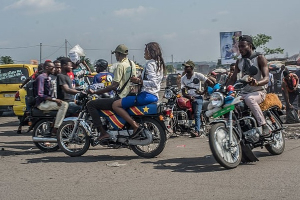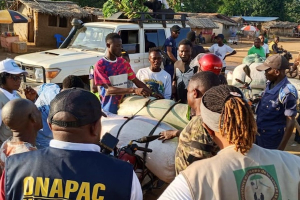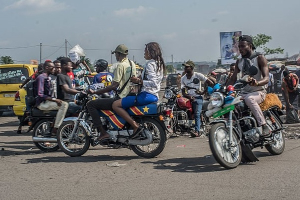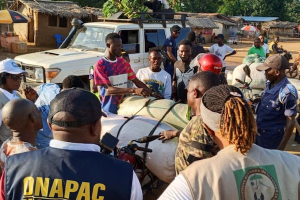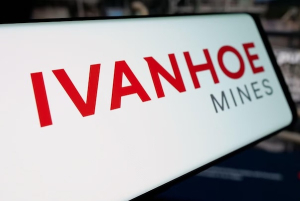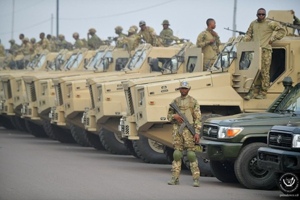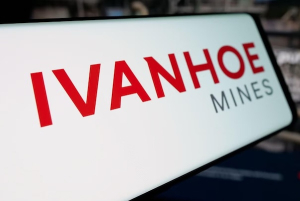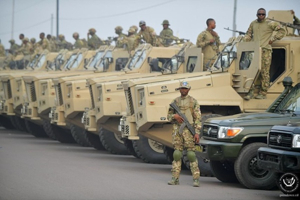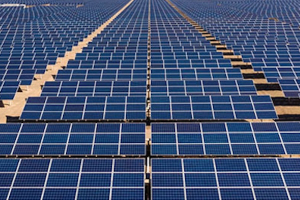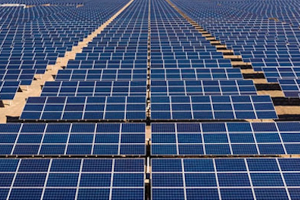Equipe Publication
Kinshasa Restricts Motorcycle, Tricycle Traffic in New Congestion Measure
The provincial government of Kinshasa has issued a directive imposing new restrictions on motorized two-wheelers in the capital, local media reported.
The directive bans motorcycle taxis from operating or parking in the Gombe district, the city’s administrative and financial center. Only brief drop-offs and pick-ups are allowed on designated roads around the district, within clearly defined limits.
The notice says private motorcycles and those used for deliveries are still permitted, provided they are registered with the urban transport division and properly marked.
Three-wheelers carrying people or goods are now banned from several major roads, including Lumumba, Sendwe, 30 Juin and Triomphal boulevards, as well as Avenue des Poids Lourds, in an effort to reduce accidents and congestion.
The measures follow instructions issued on Sept. 19 during the Council of Ministers’ 59th meeting. President Felix Tshisekedi had called for stricter regulation of motorcycle taxis, including mandatory helmet use, registering all vehicles to improve traceability, and restricting their activity to outlying areas while banning them from the city center.
In February 2024, the Congolese National Police (PNC) also banned motorcycles from entering Gombe, but the measure is often ignored. At the Socimat intersection in the middle of the district, motorcycle taxis continue to operate openly.
Amid chronic traffic jams, unreliable public transport, poor roads and limited signage or enforcement, many Kinshasa residents rely on motorcycle taxis for their flexibility. A March 2025 study by Congolese firm Target SARL found that 71% of users now say motorcycle taxis are their main mode of transport, up from 67% in 2023.
Boaz Kabeya
DRC Authorities Ban Informal Cocoa Buying, Seize Beans in Quality Drive in Ituri
Congolese agricultural authorities on Tuesday began seizing unfermented cocoa beans in the Mambasa territory of Ituri province, local media reported.
The operation, carried out by the Office National des Produits Agricoles (ONAPAC), aims to stop practices that are hurting cocoa quality in the region. The decision follows resolutions adopted at the second general assembly of coffee and cocoa farmers held in October.
ONAPAC will be assisted by the Local Council for Coffee, Cocoa, and Other Agricultural Products for Rural Development, the anti-fraud unit of the Congolese National Police, and the Mambasa Peace Court to enforce the regulations.
Other measures will also take effect, local media said. These include a formal ban on roaming, informal buying practices to combat fraud, curb unfair competition, and improve traceability. Buyer identification will also be required to secure transactions and strengthen accountability in the supply chain.
The measures come amid a sharp drop in cocoa prices in October. Local media reported that the price per kilogram fell from 20,000 Congolese francs to 6,000 francs in several buying houses in Mambasa and Irumu.
While global prices have been affected by a production recovery in West Africa, part of the local collapse is due to quality issues. Dieudonne Kambale, an agronomist with ESCO Kivu, quoted by 7sur7.cd, said the region’s cocoa suffers from insufficient fermentation. Although beans should ferment for about a week, many producers dry them directly in the sun for only two to three days before selling.
The head of the local buyers’ association for agricultural and perennial products, Mumbere Musumba Jackson, made the same point in July.
Timothée Manoke
Kinshasa : taxis-motos interdits à la Gombe, tricycles bannis des grands boulevards
Le gouvernement provincial de Kinshasa a publié une note circulaire fixant de nouvelles restrictions pour la circulation des engins cyclomoteurs dans la capitale. La circulaire interdit totalement aux taxis-motos de circuler, de stationner ou d’exploiter leurs services dans la commune de la Gombe, cœur administratif et financier de la ville. Seules des déposes-reprises rapides sont autorisées sur certains axes périphériques menant vers le centre-ville, avec des délimitations précises.
La note précise néanmoins que les motos privées et celles affectées au transport ou à la livraison de marchandises demeurent autorisées, à condition d’être enregistrées et identifiées auprès de la division urbaine des transports.
Parallèlement, les tricycles transportant des personnes et des biens sont désormais interdits sur plusieurs grandes artères de la capitale, dont les boulevards Lumumba, Sendwe, du 30 Juin, Triomphal et l’avenue des Poids Lourds, afin de réduire les risques d’accidents et de congestion.
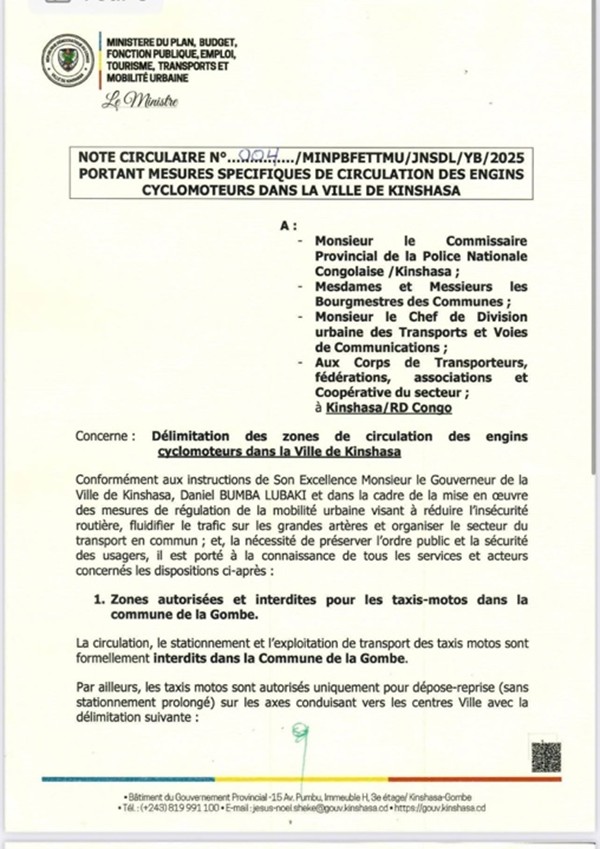 |
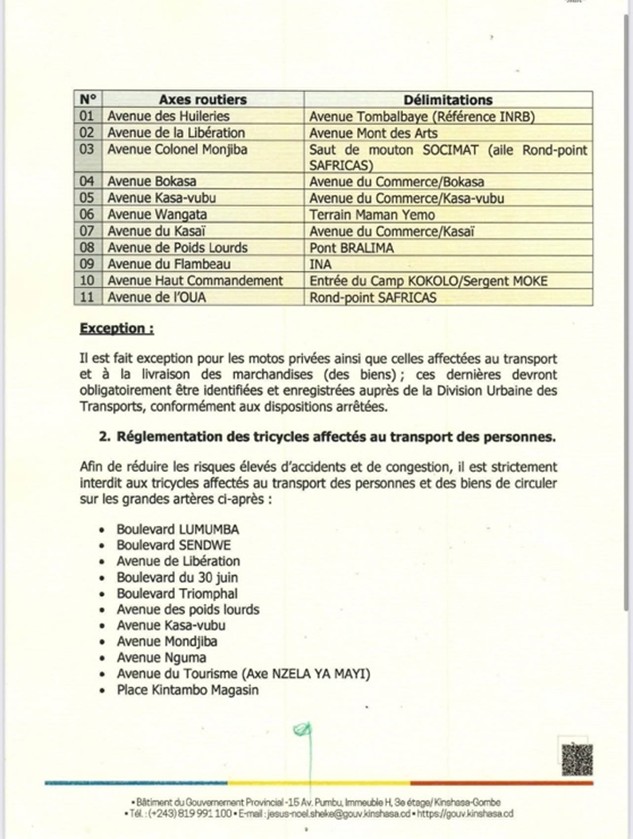 |
Ces dispositions provinciales traduisent la mise en œuvre des instructions émises le 19 septembre 2025 lors de la cinquante-neuvième réunion ordinaire du Conseil des ministres. Le président de la République, Félix Tshisekedi, avait alors insisté sur un encadrement strict des taxis-motos, avec l’obligation du port du casque pour conducteurs et passagers, l’identification systématique de tous les engins pour garantir leur traçabilité et la limitation de leur activité aux zones périphériques, interdisant formellement l’accès au centre-ville.
En février 2024, la police nationale congolaise (PNC) avait déjà interdit l’accès des motocyclistes à la commune de la Gombe. Mais cette interdiction est régulièrement bravée. Au carrefour Socimat, en plein cœur de la commune, des motos-taxis proposent ouvertement leurs services aux usagers.
Face aux embouteillages interminables, à l’inefficacité croissante des transports publics, au mauvais état des routes, au déficit de signalisation et de régulation du trafic, de nombreux habitants de Kinshasa adoptent la moto-taxi comme moyen de transport en raison de sa flexibilité. Selon une étude du cabinet congolais Target SARL, réalisée du 1ᵉʳ au 7 mars 2025 dans les 26 provinces du pays, 71 % des usagers désignent désormais la moto-taxi comme leur principal mode de déplacement, contre 67 % en 2023.
Boaz Kabeya
Lire aussi :
Mobilité urbaine en RDC : 71 % des usagers se tournent vers la moto-taxi en 2025
Cacao: début des saisies des lots mal fermentés en Ituri pour stabiliser les prix
Le mardi 25 novembre 2025 marque le lancement d’une opération de saisie des lots de cacao non fermentés par l’Office national des produits agricoles du Congo (ONAPAC) dans le territoire de Mambasa et ses environs. Objectif : mettre fin au désordre qui affecte la qualité du cacao dans la province de l’Ituri. Selon la presse locale, cette décision découle des résolutions adoptées lors des deuxièmes États généraux des agriculteurs des filières café et cacao, tenus en octobre dernier.
Pour cette opération, l’ONAPAC bénéficiera de l’appui du Conseil local des café-cacao et autres produits agricoles pour le développement rural (CLCCPDR-Ituri), des services d’antifraude de la Police nationale congolaise et du Tribunal de paix de Mambasa, afin d’assurer l’application stricte de la réglementation.
Parallèlement, la presse locale rapporte que d’autres mesures entreront en vigueur. Elles comprennent l’interdiction formelle des achats ambulatoires — destinée à lutter contre la fraude, à mettre fin à la concurrence déloyale et à garantir la traçabilité — ainsi que l’obligation d’identification des acheteurs, afin de sécuriser les transactions et responsabiliser les acteurs de la chaîne d’achat.
Ces actions interviennent dans un contexte de forte baisse du prix du cacao observée au cours du mois d’octobre. Les médias locaux indiquaient que le kilogramme était passé de 20 000 francs congolais à 6 000 FC dans plusieurs maisons d’achat de Mambasa et d’Irumu.
Au-delà d’une tendance mondiale marquée par la remontée de la production en Afrique de l’Ouest, une partie de cette chute est liée aux faiblesses locales de qualité. Dieudonné Kambale, agronome d’ESCO Kivu, cité par 7sur7.cd, soulignait que le cacao de cette zone souffre d’une fermentation insuffisante. Alors que le produit devrait fermenter une semaine, beaucoup de producteurs l’exposent directement au soleil deux à trois jours avant de le vendre. Un constat déjà formulé en juillet par le président des acheteurs de produits agricoles et pérennes dans la région, Mumbere Musumba Jackson.
Timothée Manoke.
Lire aussi :
Cacao : les prix à l’exportation en RDC s’effondre de 40 % en quelques mois
Qatar turns to Ivanhoe to secure critical minerals from the DRC
- QIA and Ivanhoe sign an MoU to expand cooperation on critical minerals.
- The deal follows QIA’s $500 million investment for a 4 % stake in Ivanhoe.
- Gulf states intensify investments to diversify beyond oil and secure supply chains.
Qatar’s sovereign wealth fund, the Qatar Investment Authority (QIA), signaled its intention to strengthen its partnership with Ivanhoe Mines during the Emir of Qatar’s visit to Kinshasa. The two parties signed a memorandum of understanding to frame cooperation on future projects involving critical minerals, according to a statement issued on November 21, 2025.
The head of the QIA, Mohammed Saif Al-Sowaidi, said the agreement shows the fund’s commitment to building strategic partnerships with major suppliers of critical minerals to support global efforts to develop new energy infrastructure and power advanced technologies.
The move comes less than two months after the fund entered the Canadian company’s share capital. At the end of September 2025, Ivanhoe Mines completed the issuance of 57.5 million shares to the QIA, which now holds about 4 % of the company.
The transaction enabled Ivanhoe to raise nearly $570 million, including $500 million from the QIA and $70 million from Zijin Mining, which exercised its right to maintain a 12.2 % stake to avoid dilution. CITIC did not exercise this right.
No additional financing was announced, but the MoU clearly opens the door to potential financial support from the QIA for Ivanhoe’s projects. According to Ivanhoe Mines, the agreement sets a framework for cooperation in the exploration, development, and supply of critical minerals needed for the global energy transition and for advanced technologies. It also reflects QIA’s interest in Ivanhoe’s future projects, including in the Makoko district in the DRC.
The latest estimates published by Ivanhoe in May 2025 point to 8.38 million tons of inferred copper resources across the Makoko, West Makoko, and Kitoko deposits, which are still at the exploration stage. Ivanhoe describes this cluster as one of the highest-grade discoveries in the world and the fifth-largest copper discovery of the past decade.
The MoU also notes that the QIA could use its network of financial institutions to secure preferential financing for critical mineral projects in Africa and elsewhere. The planned cooperation also covers potential mergers and acquisitions, participation in mining-related infrastructure such as logistics, energy, and water, and the joint development of refining or downstream processing capacity.
Alongside its work in the DRC, Ivanhoe is carrying out exploration programs for new sedimentary copper discoveries in Angola, Kazakhstan, and Zambia.
This momentum comes as Gulf countries scale up investments in African strategic minerals, especially the United Arab Emirates and Saudi Arabia. These states aim to diversify portfolios traditionally centered on oil, prepare for the post-oil era, and secure supplies needed for battery and low-carbon technology value chains.
According to data from the Critical Minerals: Pivotal Outlook platform, reported by Energia-Africa, Gulf countries invested $2.2 billion in African critical mineral projects during the first half of 2025. Several initiatives are emerging. Al Mansour Holding, a Qatari conglomerate, announced more than $100 billion in investments in Africa, with around $21 billion potentially dedicated to the DRC in sectors including mining.
Meanwhile, the UAE is expanding its presence through International Resources Holding, a subsidiary of IHC, which signed an agreement in June to acquire 56 % of Alphamin, operator of the Bisie tin mine — the largest in the DRC — for an estimated $367 million.
Timothée Manoke
EU approves €10mln to strengthen the FARDC’s non-lethal military capacity
-
EU allocates €10 million in non-lethal support under the European Peace Facility
-
Assistance includes command, medical, and deployment equipment for the FARDC
-
Measure follows a €20 million package adopted in 2023 for the rapid reaction brigade
The Council of the European Union has approved a new €10 million ($11.52 million at the current rate) assistance measure for the Armed Forces of the Democratic Republic of Congo (FARDC), under the European Peace Facility (EPF). The funding is intended to provide non-lethal military equipment aligned with the operational needs of the Congolese forces, according to the official statement issued by the Council.
The support consists of non-lethal equipment for command and control, deployment conditions, medical support, and surveillance patrols along river borders. The first deliveries are expected before the end of 2026, the Council said.
According to the European institution, this assistance will strengthen the capacity of the Congolese armed forces to carry out their missions to protect civilians and restore state authority, in a security context marked by the continued presence of armed groups in the east of the country.
This decision is the second European support measure for the FARDC. The first, adopted on July 20, 2023, amounted to €20 million to support the 31st rapid reaction brigade based in Kindu. It was implemented in collaboration with the Belgian Ministry of Defense, which was involved in training the brigade.
That support included non-lethal individual equipment, IED-countering kits, vehicles, radios, and the rehabilitation of the brigade headquarters. The EPF’s monitoring framework also ensured oversight of equipment use and compliance with international human rights standards.
Minerais stratégiques : le Qatar mise sur Ivanhoe pour s’approvisionner en RDC
À l’occasion de la visite de l’Émir du Qatar à Kinshasa, la Qatar Investment Authority (QIA), le fonds souverain qatari, a manifesté sa volonté de renforcer sa collaboration avec Ivanhoe Mines. Les deux parties ont signé un mémorandum d’entente (MoU) destiné à encadrer une coopération dans les futurs projets liés aux minéraux critiques, selon un communiqué publié le 21 novembre 2025.
« Ce protocole d’accord témoigne de l’engagement de la QIA à établir des partenariats stratégiques avec des fournisseurs majeurs de minéraux critiques, afin de soutenir les efforts mondiaux visant à développer de nouvelles infrastructures énergétiques et à alimenter les technologies avancées », a indiqué le directeur général de la QIA, Mohammed Saif Al-Sowaidi.
Ce geste intervient moins de deux mois après l’entrée du fonds qatari au capital de l’entreprise canadienne : fin septembre 2025, Ivanhoe Mines a finalisé l’émission de 57,5 millions d’actions au profit de la QIA, désormais détentrice d’environ 4 % du capital.
Au total, l’opération a permis à Ivanhoe de lever près de 570 millions de dollars, dont 500 millions fournis par la QIA et 70 millions par Zijin Mining, qui a exercé son droit de maintien de participation à 12,2 % pour éviter toute dilution. CITIC, de son côté, n’a pas utilisé ce droit.
Aucun financement additionnel n’a été annoncé, mais ce MoU ouvre clairement la voie à d’éventuels soutiens financiers de la QIA aux projets d’Ivanhoe. Selon la communication d’Ivanhoe Mines, le MoU établit un cadre de collaboration dans la recherche, le développement et la fourniture des minéraux critiques nécessaires à la transition énergétique mondiale et à la montée en puissance des technologies avancées. La QIA y exprime également son intérêt pour les futurs projets du groupe, notamment dans le district de Makoko, en RDC.
Les dernières estimations publiées par Ivanhoe en mai 2025 évoquent 8,38 millions de tonnes de cuivre en ressources « inférées » pour l’ensemble formé des gisements Makoko, Makoko Ouest et Kitoko, encore en phase d’exploration. Ivanhoe présente cet ensemble comme l’un des plus hauts teneurs au monde et la cinquième plus importante découverte cuprifère de la dernière décennie.
Préparer l’après-pétrole
Le MoU souligne en outre que la QIA pourrait mobiliser son réseau d’institutions financières afin de faciliter l’accès à des financements préférentiels pour des projets de minéraux critiques en Afrique et ailleurs. La coopération envisagée couvre aussi d’éventuelles opérations de fusions-acquisitions, la participation à des infrastructures liées aux projets miniers (logistique, énergie, eau), ainsi que le développement conjoint de capacités de raffinage ou de transformation en aval.
Parallèlement à la RDC, Ivanhoe poursuit des programmes d’exploration pour de nouvelles découvertes de cuivre sédimentaire en Angola, au Kazakhstan et en Zambie.
Cette dynamique intervient dans un contexte d’intensification des investissements des pays du Golfe dans les minerais stratégiques africains, notamment des Émirats arabes unis et de l’Arabie saoudite. Ces États cherchent à diversifier des portefeuilles historiquement centrés sur le pétrole, afin de préparer l’ère post-pétrole et sécuriser les approvisionnements nécessaires aux chaînes de valeur des batteries et des technologies bas carbone.
Selon les données de la plateforme Critical Minerals: Pivotal Outlook, rapportées par Energia-Africa, les pays du Golfe ont injecté 2,2 milliards de dollars dans des projets liés aux minerais critiques en Afrique au premier semestre 2025. Plusieurs initiatives se développent. Al Mansour Holding, un conglomérat qatari, a annoncé plus de 100 milliards de dollars d’investissements en Afrique, dont quelque 21 milliards potentiellement destinés à la RDC dans plusieurs secteurs, notamment les mines.
De leur côté, les Émirats renforcent leur présence à travers International Resources Holding (IRH), filiale d’IHC, qui a conclu en juin un accord pour acquérir 56 % d’Alphamin, opérateur de la mine d’étain de Bisie — la plus importante de RDC — pour un montant estimé à environ 367 millions de dollars.
Timothée Manoke
Lire aussi :
Avec la visite de l’Émir à Kinshasa, le Qatar confirme ses ambitions en RDC
Mines stratégiques en RDC : le Qatar en passe d’entrer dans le capital d’Ivanhoe
Mines, infrastructures, sécurité : 21 milliards $ d’investissements qataris en vue en RDC
Cuivre de Makoko : les estimations d’Ivanhoe franchissent les 8 millions de tonnes
UE : 10 millions € pour appuyer les capacités militaires des FARDC
Le Conseil de l’Union européenne a adopté une nouvelle mesure d’assistance de 10 millions d’euros (11,52 millions de dollars au cours actuel) en faveur des Forces armées de la République démocratique du Congo (FARDC), au titre de la Facilité européenne pour la paix (FEP). Cette enveloppe vise à fournir du matériel militaire non létal répondant aux besoins opérationnels des forces congolaises, selon le communiqué officiel publié par le Conseil.
Dans le détail, il s’agit d’équipements non létaux destinés au commandement et au contrôle, à l’amélioration des conditions de déploiement, au soutien médical, ainsi qu’à la réalisation de patrouilles de surveillance le long des frontières fluviales. Les premières livraisons sont prévues avant la fin de l’année 2026, indique le Conseil.
Selon l’institution européenne, cette assistance permettra de renforcer la capacité des forces armées congolaises à accomplir leurs missions de protection des civils et de rétablissement de l’autorité de l’État, dans un contexte sécuritaire marqué par la persistance des groupes armés dans l’Est du pays.
Cette décision constitue la deuxième mesure d’appui européen destinée aux FARDC. La première, adoptée le 20 juillet 2023, portait sur 20 millions d’euros pour soutenir la 31ᵉ brigade de réaction rapide basée à Kindu. Elle avait été mise en œuvre en collaboration avec le ministère belge de la Défense, engagé dans la formation de cette brigade.
Cet appui incluait la fourniture d’équipements individuels non létaux, de kits anti-EEI, de véhicules et de radios, ainsi que la réhabilitation du siège de la brigade. Le cadre de contrôle prévu par la FEP garantissait également le suivi de l’utilisation du matériel et le respect des normes internationales en matière de droits de l’homme.
Boaz Kabeya
Lire aussi :
Lutte contre Ebola : l’Union européenne mobilise 1,8 million € pour la RDC
AEE Power Commits $42.7 Million to Electrify Mwene-Ditu
-
AEE Power plans to invest $42.7 million to build a 14.04 MW hybrid mini-grid for Mwene-Ditu.
-
The system will combine solar, battery storage and backup thermal generation to guarantee reliability.
-
The mini-grid will serve up to 25,018 clients within five years, with electricity sales expected to reach 34,192 MWh by Year 10.
AEE Power, a pan-African developer specialized in power infrastructure in sub-Saharan Africa, plans to invest $42.7 million to build a 14.04 MW mini-grid designed to electrify Mwene-Ditu, the second-largest city in the Lomami province. The company presented the project during a workshop that gathered local economic operators, organized in partnership with VSI Afrique, a consulting firm focused on energy and infrastructure.
The future mini-grid will combine solar generation, battery storage and backup thermal power. The company plans to install 14.04 MWp of photovoltaic solar capacity (11.7 MW AC) alongside 4.128 MWh of storage with 1.032 MW output. A 2.53 MVA thermal plant will secure continuous supply when solar energy falls short.
Roger Ilunga Tshintu, AEE Power’s representative, said the distribution network will include 46.39 km of medium-voltage lines, 96.37 km of low-voltage lines, 20,990 prepaid meters for residential and commercial users, and 2,313 public lighting points.
AEE Power expects the mini-grid to serve 14,690 customers during its first year of operation and 25,018 clients by its fifth year. Electricity sales should reach 13,471 MWh after five years and 34,192 MWh by Year 10.
The project will supply households, SMEs, public buildings, hospitals, and telecommunications facilities. The company intends to design the infrastructure to ensure 50% renewable penetration with less than 2% downtime.
AEE Power already operates in the Democratic Republic of Congo across generation, transmission and distribution. Its flagship projects include the 11 GW Inga 3 hydropower project, the Fungurume–Kasumbalesa and Goma–Bukavu high-voltage lines, and the Kinshasa distribution network, which includes nearly 19,600 new connections.
This article was initially published in French by Ronsard Luabeya
Adapted in English by Ange Jason Quenum
AEE Power met 42,7 millions $ sur la table pour électrifier Mwene-Ditu
AEE Power, développeur panafricain spécialisé dans les infrastructures électriques en Afrique subsaharienne, projette d’investir 42,7 millions de dollars pour construire un mini-réseau électrique de 14,04 MW destiné à électrifier Mwene-Ditu, deuxième ville de la province de Lomami. Le projet a été présenté lors d’un atelier réunissant les opérateurs économiques locaux, organisé par l’entreprise en collaboration avec le cabinet de conseil VSI Afrique, spécialisé dans les projets énergétiques et d’infrastructures.
Le futur mini-réseau combinera énergie solaire, stockage par batteries et génération thermique de secours. La capacité solaire photovoltaïque prévue est de 14,04 MWc (11,7 MW AC), associée à un système de stockage de 4,128 MWh pour une puissance de 1,032 MW. Une centrale thermique de 2,53 MVA assurera l’alimentation continue en cas d’insuffisance solaire.
Selon Roger Ilunga Tshintu, représentant d’AEE Power, le réseau de distribution comprendra 46,39 km de lignes moyenne tension, 96,37 km de lignes basse tension, 20 990 compteurs prépayés destinés aux clients résidentiels et commerciaux, ainsi que 2 313 points d’éclairage public.
Les projections indiquent que le mini-réseau desservira 14 690 clients dès sa première année d’exploitation et atteindra 25 018 clients au terme de la cinquième année. Les ventes totales d’électricité devraient atteindre 13 471 MWh à cinq ans, puis 34 192 MWh à l’horizon de la dixième année.
Le projet couvrira les ménages, les petites et moyennes entreprises, les bâtiments publics, ainsi que de grands consommateurs tels que les hôpitaux et les sites de télécommunications. L’infrastructure sera conçue pour garantir un taux de pénétration de 50 % d’énergie renouvelable, avec un temps d’indisponibilité inférieur à 2 %.
Présent en République démocratique du Congo, AEE Power intervient dans la production, la transmission et la distribution d’électricité. Parmi ses projets emblématiques figurent notamment la centrale hydroélectrique Inga 3 (11 GW), les lignes haute tension Fungurume–Kasumbalesa et Goma–Bukavu, ainsi que le réseau de distribution de Kinshasa, comprenant près de 19 600 nouveaux branchements.
Ronsard Luabeya





